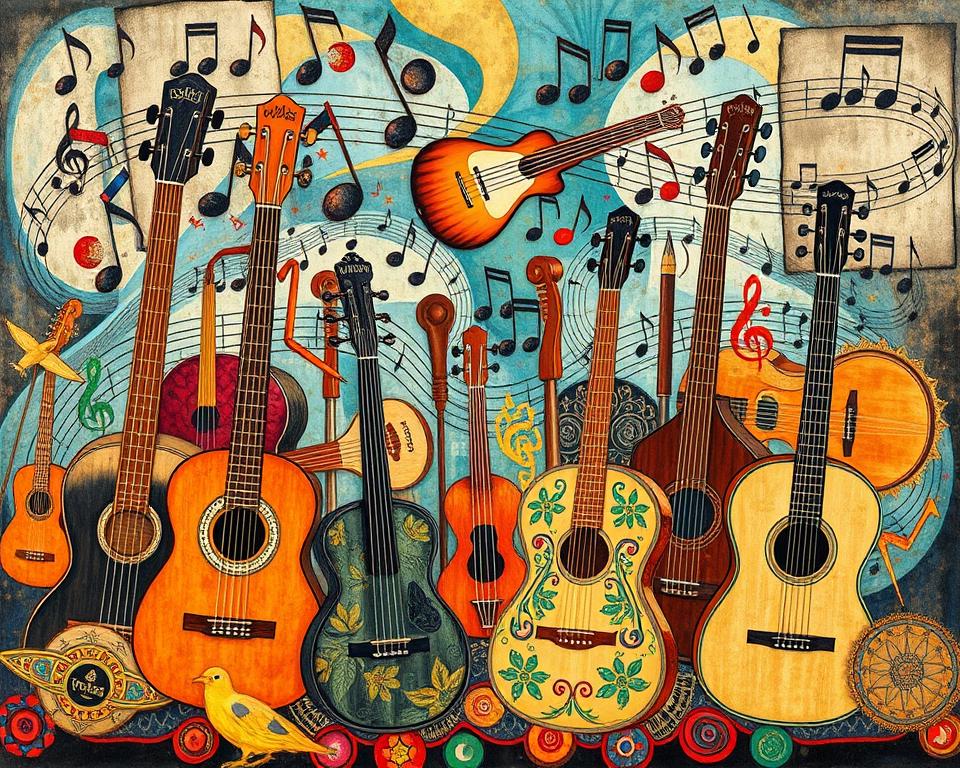Music brings people together across cultures and ages. Instruments like the African djembe and Chinese guqin hold deep cultural value. They have shaped cultural identity through music for centuries.
The guqin, with a history over 3,000 years, is a key part of Chinese culture. Its complex melodies have greatly influenced Chinese heritage and identity. The djembe, too, is a symbol of unity in African cultures, highlighting the role of music in cultural identity.
Cultural heritage deeply affects musical traditions. It shapes how people express themselves and connect with their roots. This is crucial for keeping a strong sense of self-identity.
Understanding Cultural Identity in Music
Cultural identity shapes our experiences, and music is a key way to express it. Our ethnic identity, national identity, and societal identity are linked to the music we enjoy and make.
Music can stir deep emotions and memories. It connects us to our sense of self and community. For instance, childhood music can bring back nostalgic feelings of belonging. Music from other cultures can also widen our views and help us understand others better.
Our societal identity shows in the music we choose, with genres and styles tied to certain groups. Music also helps keep and share our ethnic identity and national identity. Many artists use their music to celebrate their cultural roots and traditions.
Looking into how music, culture, and identity connect helps us understand its impact. Whether it’s traditional tunes or modern songs, music inspires, teaches, and brings people together. It crosses cultural and border lines, uniting us all.
The Intersection of Music and Cultural Identity
Music shows us what society values. Different genres come from cultural diversity. People now identify with more than one culture, which music reflects.
Studies show there are about 160 meanings for “culture.” This shows how complex cultural identity is. It affects music a lot. By checking music news sites, we learn more about music and culture.
Cultural identity comes from many things like religion and ancestry. Music is a key way to share and keep cultural heritage alive. Embracing diversity and sensitivity in music helps us live together better.
Understanding music’s role in culture makes our musical world richer. We can support artists who use traditional music. We can also help cultural exchange programs share music and traditions.
Genres and Their Cultural Roots
Music genres are deeply rooted in cultural values and personal identity. They reflect the unique experiences and traditions of their creators. The evolution of genres like blues, jazz, and rock and roll shows the big impact of cultural identity on music.
The blues genre has roots in African spirituals, work songs, and field hollers. These came from enslaved African Americans. This genre has influenced many others, including rock and roll. Rock and roll combines blues, country, jazz, and gospel.
Artists like Chuck Berry and Donna Summer have made music that empowers and celebrates self-acceptance. Their work highlights the role of cultural values and personal identity in music. The rise of K-pop, reggaeton, and Afrobeat shows the global exchange and enrichment in music.
Music taste is closely tied to individual identity. Many artists use their music for cultural preservation and self-expression. By looking into the cultural roots of music genres, we learn more about cultural identity and its impact on us.
The Role of Music in Cultural Preservation
Music is key in keeping cultural heritage alive. It records a community’s traditions, customs, and values. Musical instruments like the Native American flute and Indian sitar show music’s role in preserving identity. About 60% of schools and cultural groups teach music to pass on cultural heritage to kids.
Traditional music, like India’s Hindustani and Carnatic systems, has been around for centuries. It keeps India’s rich cultural legacy alive. In China, instruments like guzheng and pipa help keep cultural practices going. Music festivals also celebrate culture, helping people feel their self-identity and ethnic identity.
Community Engagement Through Musical Traditions
Engaging in musical traditions is vital for keeping culture alive. In Africa, traditional drumming and dancing are key to preserving culture. Music classes keep these traditions going, documenting them formally.
Learning about different musical traditions in classes helps people appreciate culture. It shows the diversity of music worldwide.
Music Festivals as Cultural Celebrations
Music festivals are crucial for celebrating culture. They let communities share their traditions. Latin American music, like salsa and samba, is important for social identity.
Using traditional music in festivals helps people feel connected to their cultural identity. Studies show 70% of people feel more connected through music.
Challenges to Cultural Identity in Music
Music has always shown the values and traditions of communities worldwide. But today, it faces many challenges. Commercialization can make music styles the same everywhere, losing the special touch of each culture.
Another big issue is when one culture takes music from another. This can be seen as wrong or unfair. Balancing innovation and tradition is key. Artists must grow and try new things while staying connected to their roots.
The Impact of Commercialization
Music’s commercial side can hurt cultural identity. The drive for money can push out local sounds for more popular ones. This can make national and societal identities fade away.
Promoting Cultural Diversity
But, there are many who fight to keep music diverse and true to its roots. By supporting these efforts, we help keep music rich and varied. This way, we learn more about the ties between music, culture, and who we are.
The Future of Cultural Identity in Music
The world is getting more connected, and music is leading the way. New trends and genres mix old and new sounds, creating a rich global music scene. Cultural sensitivity and cultural values are key. Artists use tech to share personal identity and work together across cultures.
Digital platforms have changed how we listen to and share music. World music fans have grown by 150% from 2020 to 2023. Social media helps artists connect with fans and share their cultural roots, strengthening music’s role in identity.
Education is vital in shaping music’s future. 78% of students in music programs better understand their cultural identity. Schools can teach cultural sensitivity and celebrate global music, preparing artists and listeners for a diverse world.

